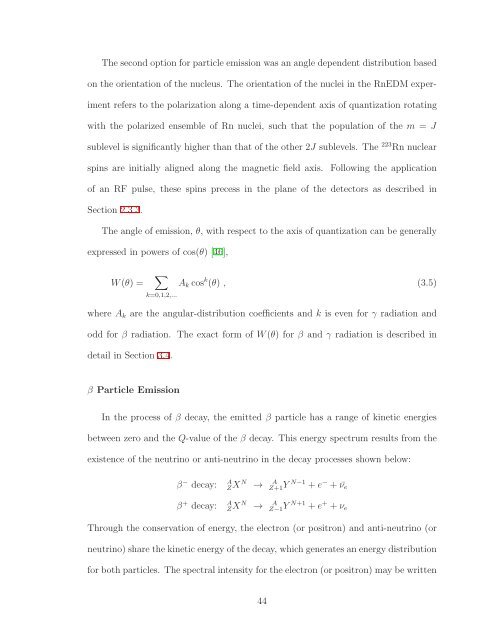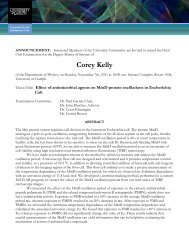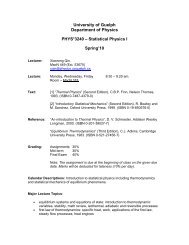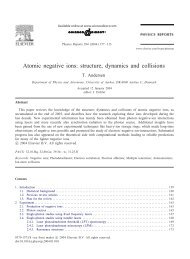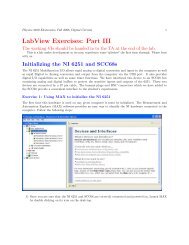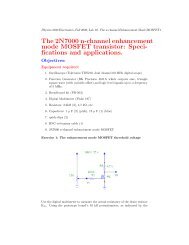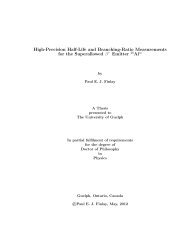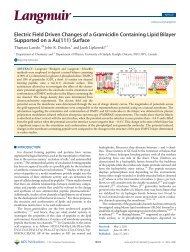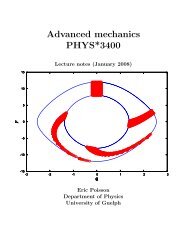Geant4 Simulations for the Radon Electric Dipole Moment Search at
Geant4 Simulations for the Radon Electric Dipole Moment Search at
Geant4 Simulations for the Radon Electric Dipole Moment Search at
Create successful ePaper yourself
Turn your PDF publications into a flip-book with our unique Google optimized e-Paper software.
The second option<strong>for</strong> particle emission was anangle dependent distribution based<br />
on <strong>the</strong> orient<strong>at</strong>ion of <strong>the</strong> nucleus. The orient<strong>at</strong>ion of <strong>the</strong> nuclei in <strong>the</strong> RnEDM experiment<br />
refers to <strong>the</strong> polariz<strong>at</strong>ion along a time-dependent axis of quantiz<strong>at</strong>ion rot<strong>at</strong>ing<br />
with <strong>the</strong> polarized ensemble of Rn nuclei, such th<strong>at</strong> <strong>the</strong> popul<strong>at</strong>ion of <strong>the</strong> m = J<br />
sublevel is significantly higher than th<strong>at</strong> of <strong>the</strong> o<strong>the</strong>r 2J sublevels. The 223 Rn nuclear<br />
spins are initially aligned along <strong>the</strong> magnetic field axis. Following <strong>the</strong> applic<strong>at</strong>ion<br />
of an RF pulse, <strong>the</strong>se spins precess in <strong>the</strong> plane of <strong>the</strong> detectors as described in<br />
Section 2.3.3.<br />
The angle of emission, θ, with respect to <strong>the</strong> axis of quantiz<strong>at</strong>ion can be generally<br />
expressed in powers of cos(θ) [46],<br />
W(θ) = ∑<br />
A k cos k (θ) , (3.5)<br />
k=0,1,2,...<br />
where A k are <strong>the</strong> angular-distribution coefficients and k is even <strong>for</strong> γ radi<strong>at</strong>ion and<br />
odd <strong>for</strong> β radi<strong>at</strong>ion. The exact <strong>for</strong>m of W(θ) <strong>for</strong> β and γ radi<strong>at</strong>ion is described in<br />
detail in Section 3.4.<br />
β Particle Emission<br />
In <strong>the</strong> process of β decay, <strong>the</strong> emitted β particle has a range of kinetic energies<br />
between zero and <strong>the</strong> Q-value of <strong>the</strong> β decay. This energy spectrum results from <strong>the</strong><br />
existence of <strong>the</strong> neutrino or anti-neutrino in <strong>the</strong> decay processes shown below:<br />
β − decay:<br />
A<br />
Z X N → A<br />
Z+1 Y N−1 +e − + ¯ν e<br />
β + decay:<br />
A<br />
Z X N → A<br />
Z−1 Y N+1 +e + +ν e<br />
Through <strong>the</strong> conserv<strong>at</strong>ion of energy, <strong>the</strong> electron (or positron) and anti-neutrino (or<br />
neutrino)share<strong>the</strong>kineticenergyof<strong>the</strong>decay, whichgener<strong>at</strong>esanenergydistribution<br />
<strong>for</strong> bothparticles. The spectral intensity <strong>for</strong> <strong>the</strong>electron (or positron) may bewritten<br />
44


